“hear +宾语+宾补”的用法
- 格式:ppt
- 大小:349.50 KB
- 文档页数:5
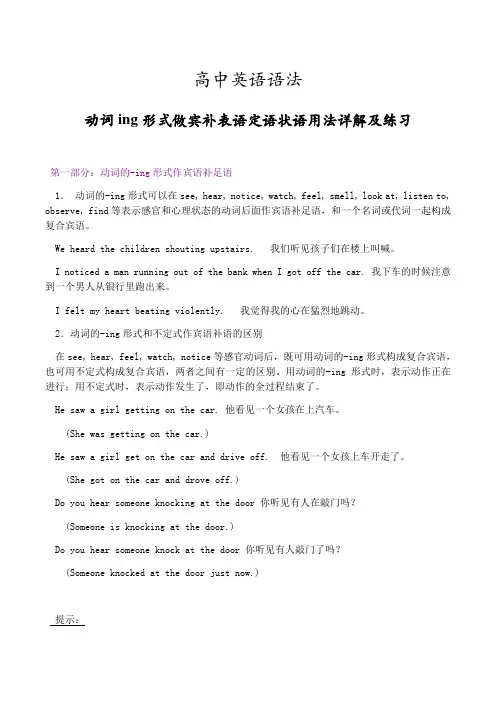
高中英语语法动词ing形式做宾补表语定语状语用法详解及练习第一部分:动词的-ing形式作宾语补足语1.动词的-ing形式可以在see, hear, notice, watch, feel, smell, look at, listen to, observe, find等表示感官和心理状态的动词后面作宾语补足语,和一个名词或代词一起构成复合宾语。
We heard the children shouting upstairs. 我们听见孩子们在楼上叫喊。
I noticed a man running out of the bank when I got off the car. 我下车的时候注意到一个男人从银行里跑出来。
I felt my heart beating violently. 我觉得我的心在猛烈地跳动。
2.动词的-ing形式和不定式作宾语补语的区别在see, hear, feel, watch, notice等感官动词后,既可用动词的-ing形式构成复合宾语,也可用不定式构成复合宾语,两者之间有一定的区别。
用动词的-ing形式时,表示动作正在进行;用不定式时,表示动作发生了,即动作的全过程结束了。
He saw a girl getting on the car. 他看见一个女孩在上汽车。
(She was getting on the car.)He saw a girl get on the car and drive off. 他看见一个女孩上车开走了。
(She got on the car and drove off.)Do you hear someone knocking at the door 你听见有人在敲门吗?(Someone is knocking at the door.)Do you hear someone knock at the door 你听见有人敲门了吗?(Someone knocked at the door just now.)提示:如果宾语补足语是一系列的动作,通常只能用不定式来表示,不用动词的-ing形式。

“感使动词+宾语+宾语补足语”结构中宾语补足语的用法定义1.所谓感官动词,是指表示人的大脑感觉器官所发出的动作的动词。
如:notice / observe / see / look at / watch / hear / listen to / feel(常见的共8词).2.使役动词是指具有使、让意义的动词。
如:have/ let / make(常见的共3词)。
记忆与使用难点一:如何系统、准确地熟记常见的感官、使役动词口诀:“注意、观察、三看、二听、一感觉;三个使役半帮助。
”注意:“半帮助”是为了易记加上去的(因help后接的to可省可不省,故叫“半帮助”)。
难点二:对感官、使役动词的主动结构后接非谓语动词作宾补的区别先看感官动词主动结构的用法(以hear为例):hear sb. do/ doing/ done'即其后可接do(省to)/ doing/ done作宾补。
区别是:1)do/ doing均表主动关系,done表被动关系。
2)do/ doing都可表主动,但do指整个动作,经常性动作或强调动作完成了。
doing指动作正在进行或动作的某个片断。
3)done指某事由别人做(被做),也作“遭受”解。
试比较:A)I heared him sing a song. 我听他唱了一首歌(指自始至终整个过程)。
B)I heared him singing a song. 我听见他正在唱歌唱(指当时动作的某个片断)。
C)I heared a song sung.我听见(有人)唱歌(逻辑主语“歌”与“唱”是被动关系。
)再看使役动词主动结构的用法:have sb. do/ doing/ done, make/let sb. do/ donehave后也接do(省to)/ doing/ done作宾补,区别是:1)do/ doing 均表主动关系,done表被动关系。
2)do/ doing虽然都表主动,但do指目前和将来或经常性、反复性的动作。
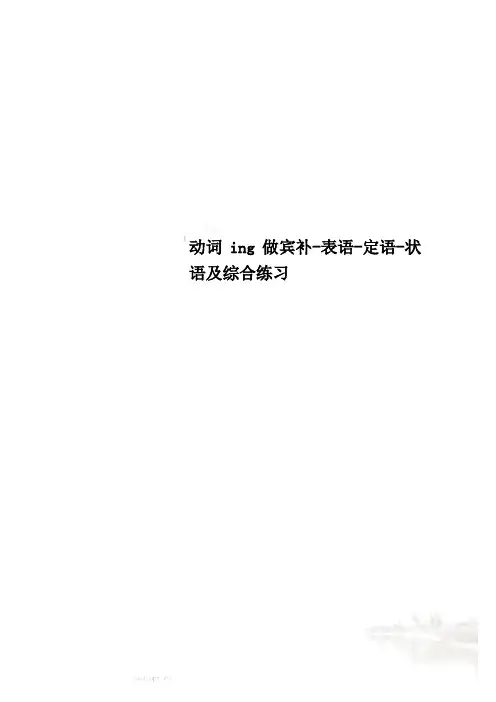
动词ing做宾补-表语-定语-状语及综合练习2高中英语语法动词ing形式做宾补表语定语状语用法详解及练习第一部分:动词的-ing形式作宾语补足语1.动词的-ing形式可以在see, hear, notice, watch, feel, smell, look at, listen to, observe, find 等表示感官和心理状态的动词后面作宾语补足语,和一个名词或代词一起构成复合宾语。
We heard the children shouting upstairs. 我们听见孩子们在楼上叫喊。
I noticed a man running out of the bank when I got off the car. 我下车的时候注意到一个男人从银行里跑出来。
I felt my heart beating violently. 我觉得我的心在猛烈地跳动。
2.动词的-ing形式和不定式作宾语补语的区别在see, hear, feel, watch, notice等感官动词后,既可用动词的-ing形式构成复合宾语,也可用不定式构成复合宾语,两者之间有一定的区别。
用动词的-ing形式时,表示动作正在进行;用不定式时,表示动作发生了,即动作的全过程结束了。
He saw a girl getting on the car. 他看见一个女孩在上汽车。
(She was getting on the car.)He saw a girl get on the car and drive off. 他看见一个女孩上车开走了。
(She got on the car and drove off.)Do you hear someone knocking at the door 你听见有人在敲门吗?(Someone is knocking at the door.)Do you hear someone knock at the door 你听见有人敲门了吗?(Someone knocked at the door just now.)提示:如果宾语补足语是一系列的动作,通常只能用不定式来表示,不用动词的-ing形式。
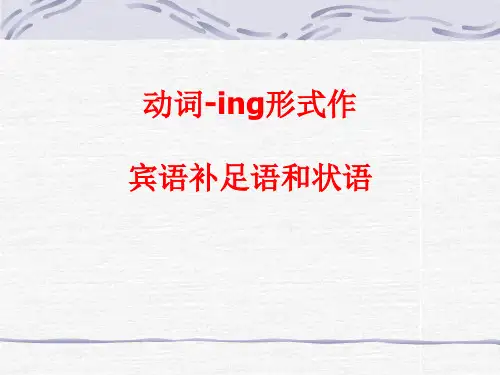
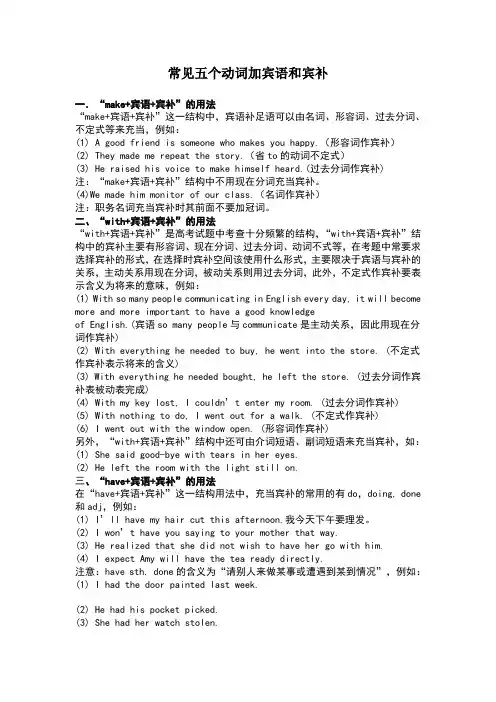
常见五个动词加宾语和宾补一.“make+宾语+宾补”的用法“make+宾语+宾补”这一结构中,宾语补足语可以由名词、形容词、过去分词、不定式等来充当,例如:(1) A good friend is someone who makes you happy.(形容词作宾补)(2) They made me repeat the story.(省to的动词不定式)(3) He raised his voice to make himself heard.(过去分词作宾补)注:“make+宾语+宾补”结构中不用现在分词充当宾补。
(4)We made him monitor of our class.(名词作宾补)注:职务名词充当宾补时其前面不要加冠词。
二、“with+宾语+宾补”的用法“with+宾语+宾补”是高考试题中考查十分频繁的结构,“with+宾语+宾补”结构中的宾补主要有形容词、现在分词、过去分词、动词不式等,在考题中常要求选择宾补的形式,在选择时宾补空间该使用什么形式,主要限决于宾语与宾补的关系,主动关系用现在分词,被动关系则用过去分词,此外,不定式作宾补要表示含义为将来的意味,例如:(1) With so many people communicating in English every day, it will become more and more important to have a good knowledgeof English.(宾语so many people与communicate是主动关系,因此用现在分词作宾补)(2) With everything he needed to buy, he went into the store. (不定式作宾补表示将来的含义)(3) With everything he needed bought, he left the store. (过去分词作宾补表被动表完成)(4) With my key lost, I couldn’t enter my room. (过去分词作宾补)(5) With nothing to do, I went out for a walk. (不定式作宾补)(6) I went out with the window open. (形容词作宾补)另外,“with+宾语+宾补”结构中还可由介词短语、副词短语来充当宾补,如:(1) She said good-bye with tears in her eyes.(2) He left the room with the light still on.三、“have+宾语+宾补”的用法在“have+宾语+宾补”这一结构用法中,充当宾补的常用的有do,doing, done 和adj,例如:(1) I’ll have my hair cut this afternoon.我今天下午要理发。

宾语补足语总汇Company Document number:WTUT-WT88Y-W8BBGB-BWYTT-19998宾语补足语总汇六、具体说明:(一)副词作宾语补足语I found him in yesterday.(二)常接形容词作宾语补足语的动词有:keep, make, find等。
如:We must keep our classroom clean.(三)常接名词作宾语补足语的动词有:call, name, make, think等。
如:We call them mooncakes.(四)常接动词-ing形式作宾语补足语的动词有:see, watch, hear, find, keep 等。
如:In the country, we can hear birds singing.(五)常接介词短语作宾语补足语的动词有:keep, find, leave等。
如:I left my pen on my desk at home.(六)不定式作宾语补足语1. 常接带to的动词不定式作宾语补足语的动词有:ask, tell, want, teach, wish 等;2. 接不带to的动词不定式作宾语补足语的动词有:see, watch, hear, make, let advise, allow, ask, beg, command, tell, invite, force, oblige, get, help, encourage, persuade, permit, remind, request, order, warn, cause等。
如:I often see him play football.She often asks me to help her.We don't allow such things to happen again.Most of the parents agree to forbid their children to smoke.She asked me to answer the phone in her absence.Please remind me to leave her this note.She requested him to go with her.3. 用不定式作宾语补足语的几种说明:①help后面作宾语补足语的动词不定式可以带to也可以不带to。
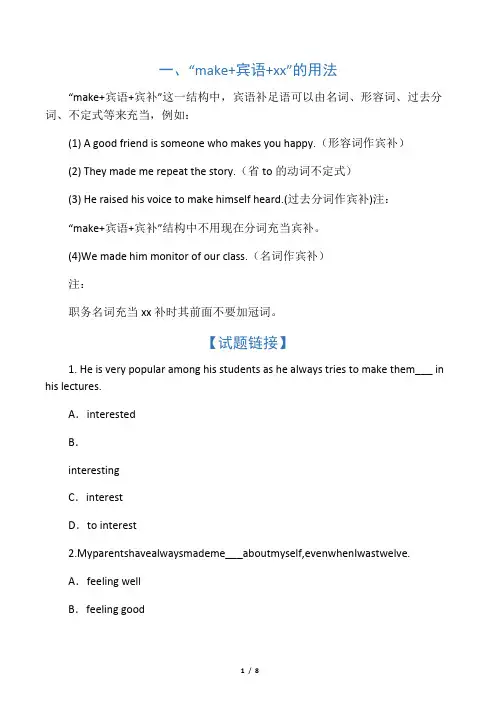
一、“make+宾语+xx”的用法“make+宾语+宾补”这一结构中,宾语补足语可以由名词、形容词、过去分词、不定式等来充当,例如:(1) A good friend is someone who makes you happy.(形容词作宾补)(2) They made me repeat the story.(省to的动词不定式)(3) He raised his voice to make himself heard.(过去分词作宾补)注:“make+宾语+宾补”结构中不用现在分词充当宾补。
(4)We made him monitor of our class.(名词作宾补)注:职务名词充当xx补时其前面不要加冠词。
【试题链接】1. He is very popular among his students as he always tries to make them___ in his lectures.A.interestedB.interestingC.interestD.to interest2.Myparentshavealwaysmademe___aboutmyself,evenwhenIwastwelve.A.feeling wellB.feeling goodC.feel wellD.feel good答案:1.A2.D二、“with+宾语+xx”的用法“with+宾语+宾补”是高考试题中考查十分频繁的结构,“with+宾语+宾补”结构中的宾补主要有形容词、现在分词、过去分词、动词不定式等,在考题中常要求选择宾补的形式,在选择时宾补空间该使用什么形式,主要限决于宾语与宾补的关系,主动关系用现在分词,被动关系则用过去分词,此外,不定式作宾补要表示含义为将来的意味,例如:(2) With everything he need to buy, he went into the store. (不定式作宾补表示将来的含义)(3) With everything he need bought, he left the store. (过去分词作宾补表被动表完成)(4) With my key lost, I couldn’t enter my room. (过去分词作宾补)(5) With nothing to do, I went out for a walk. (不定式作宾补)(6) I went out with the window open. (形容词作宾补)另外,“with+宾语+宾补”结构中还可由介词短语、副词短语来充当宾补,如:(1) She said good-bye with tears in her eyes.(2) He left the room with the light still on.【试题链接】1. ----Come on, please give me some ideas about the project.----Sorry. With so much work ___ my mind, I almost break down.A.filledB.fillingC.to fillD.being filled2. John received an invitation to dinner, and with his work ___ hegladly accepted it.A.finishedB.finishingC.having finishedD.was finished3. I couldn’t to my homework with all the noise___.A.going onB.goes onC.went onD.to go on答案:1. B2. A3. A三、“have+宾语+xx”的用法在“have+宾语+宾补”这一结构用法中,充当宾补的常用的有do,doing,done 和adj,例如:(1) I’ll have my hair cut this afternoon.我今天下午要理发。
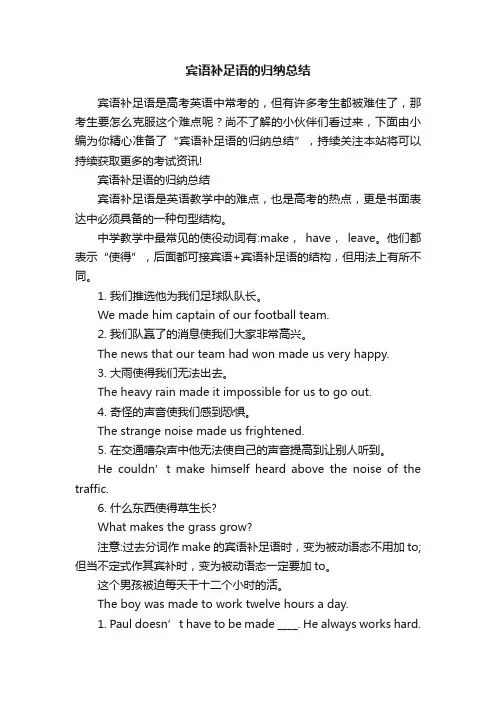
宾语补足语的归纳总结宾语补足语是高考英语中常考的,但有许多考生都被难住了,那考生要怎么克服这个难点呢?尚不了解的小伙伴们看过来,下面由小编为你精心准备了“宾语补足语的归纳总结”,持续关注本站将可以持续获取更多的考试资讯!宾语补足语的归纳总结宾语补足语是英语教学中的难点,也是高考的热点,更是书面表达中必须具备的一种句型结构。
中学教学中最常见的使役动词有:make,have,leave。
他们都表示“使得”,后面都可接宾语+宾语补足语的结构,但用法上有所不同。
1. 我们推选他为我们足球队队长。
We made him captain of our football team.2. 我们队赢了的消息使我们大家非常高兴。
The news that our team had won made us very happy.3. 大雨使得我们无法出去。
The heavy rain made it impossible for us to go out.4. 奇怪的声音使我们感到恐惧。
The strange noise made us frightened.5. 在交通嘈杂声中他无法使自己的声音提高到让别人听到。
He couldn’t make himself heard above the noise of the traffic.6. 什么东西使得草生长?What makes the grass grow?注意:过去分词作make的宾语补足语时,变为被动语态不用加to; 但当不定式作其宾补时,变为被动语态一定要加to。
这个男孩被迫每天干十二个小时的活。
The boy was made to work twelve hours a day.1. Paul doesn’t have to be made ____. He always works hard.A. learnB. to learnC. learnedD. learning2. The result of the entrance exams was not made ____ to the public until last Thursday.A. knowingB. knownC. to knowD. to be known答案:1.B2.Bhave sb. do sth.使得某人做某事have sb. doing sth.使得某人一直做某事have sth. done使得某事被做1. The teacher had her ____(recite) the text again.2. He wants to have his eyes ____(examine) tomorrow.3. Be careful, or you’ll have your hands ____(hurt).4. He had the girl ____(stand) in the classroom the whole morning.5. He had the walls ____(paint) this morning.答案:1.recite 2.examined 3.hurt 4.standing 5.painted只能用doing的情况1. 表示正在发生Be quick. They have the car waiting for you at the school gate.2. 否定句中表示(不能)容忍某人做……Iwon’t have him cheating in the exam.3. 表示某一时间内一直延续不断的动作He had us laughing all through the meals.1. I’ve had my radio ____ so soon because my father had me ____ it. A. repair; done B. repaired; do C. repairing; do D. repaired; done2. You can’t have the horse ____ all the way. It’s too hot.A. runB. to runC. runningD. to be running3. Mrs. Brown was much disappointed to see the washing machine she had had ____ went wrong again.A. itB. it repairedC. repairedD. to be repaired4. We will have you ____(know) that the machine has been made ____(work) at full speed.答案:1.B 2.C 3.C 4.know, to work1. 用形容词作宾语补足语出去时,不要关门。
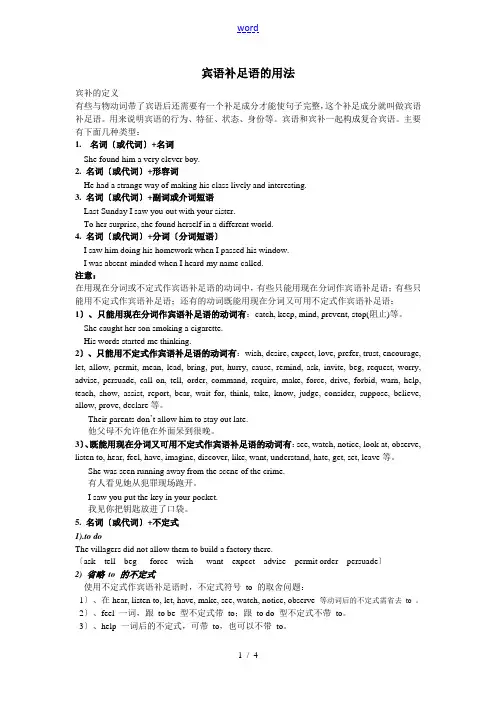
宾语补足语的用法宾补的定义有些与物动词带了宾语后还需要有一个补足成分才能使句子完整,这个补足成分就叫做宾语补足语。
用来说明宾语的行为、特征、状态、身份等。
宾语和宾补一起构成复合宾语。
主要有下面几种类型:1.名词〔或代词〕+名词She found him a very clever boy.2. 名词〔或代词〕+形容词He had a strange way of making his class lively and interesting.3. 名词〔或代词〕+副词或介词短语Last Sunday I saw you out with your sister.To her surprise, she found herself in a different world.4. 名词〔或代词〕+分词〔分词短语〕I saw him doing his homework when I passed his window.I was absent-minded when I heard my name called.注意:在用现在分词或不定式作宾语补足语的动词中,有些只能用现在分词作宾语补足语;有些只能用不定式作宾语补足语;还有的动词既能用现在分词又可用不定式作宾语补足语:1〕、只能用现在分词作宾语补足语的动词有:catch, keep, mind, prevent, stop(阻止)等。
She caught her son smoking a cigarette.His words started me thinking.2〕、只能用不定式作宾语补足语的动词有:wish, desire, expect, love, prefer, trust, encourage, let, allow, permit, mean, lead, bring, put, hurry, cause, remind, ask, invite, beg, request, worry, advise, persuade, call on, tell, order, command, require, make, force, drive, forbid, warn, help, teach, show, assist, report, bear, wait for, think, take, know, judge, consider, suppose, believe, allow, prove, declare等。

第2讲非谓语动词做宾补的归纳教学目标:在前面非谓语动词单项选择的基础上,进行理论和实践的提高,争取在综合能力上有所突破。
第一部分:非谓语动词做宾补的情形和考点一:分词、不定式做宾语补足语的区别1.感官动词see,watch,observe,look at, hear, listen to ,notice等和使役动词have后面的宾补有两种情况:①当宾语与宾语补足语这个动作之间存在逻辑上的主动关系时,需用不带to的动词不定式或者现在分词doing。
前者表动作已完成,后者表动作正在进行。
如:I heard her sing an Englihs song just now.(主动,完成)I heard her singing an English song when I passed by.(主动,进行)②当宾语与宾语补足语之间存在逻辑上的被动关系时,需用过去分词或现在分词的被动形态being done(前者表完成或者没有具体的时间性,而后者表示正在进行)如:I heard an English song being sung when I passed by the room.I want to have my hair cut.(被动,没有具体的时间性)一定注意:不及物动词的过去分词不表被动,只表示这个动作处于完成状态。
如:I looked down at my neck and found my necklace gone.(表完成)I was surprised to find my hometown changed so much .(不是说被改变,而是说变化已然产生了,注意这个change是不及物动词,如the world is always changing.一样)2.使役动词let后加复合宾语时,当宾语与宾语补足语在逻辑上为主动关系时,需用不带to的动词不定式;当宾语与宾语补足语在逻辑上为被动关系时,宾语补足语用“be + 过去分词“;如:Don’t let your child play with matches.Let there be no mistake about it.Let the work be done immediately.3.leave后接非谓语动词做补足语的时候,意思为“使…处于某种状态”搭配有:①leave sb doing sth.②Leave sth. undone,unfinished,unsettled,untouched③ Leave sb. to do sth.④ Leave sth. to be done如:It’s bad for you to leave the A/C working all night.The guests left most of the dishes untouched.He left, leaving me to do all the rest work.We hurriedly ended our meeting, leaving many problems to be settled.4.have, get后面接非谓语动词做宾语补足语时,意思为“使,让,叫”搭配有:①have/get sth. done (让某事由别人去做,让别人帮做某事)如:I’ll have/get my bike repaired tomorrow.②Have sth.done “使遭受…”如:Jack had his leg broken in a match.③Have sb/sth. doing 让…持续地做某事④Get sb./sth. doing 使…开始行动起来如:After a rest, the officer got the soldiers moving to the front.一定注意:have sb. doing 若是用在否定句中,have意思是“容忍”如:I won’t have you speaking to your dad like that.⑤have sb. do sth.Get sb. to do sth. 叫某人去做某事如:My mother had me go to the shop and buy some salt.二:下列动词后跟带to的不定式做补语Advise sb. to do, allow sb. to do, ask sb. to do,beg sb. to do,cause sb. to do,encourage sb. to do,expect sb. to do,forbid sb. to do, force sb. to do,get sb. to do, intend sb. to do, invite sb. to do,like sb. to do,love sb. to do,order sb. to do, persuade sb. to do, prefer sb. to do, require sb. to do, teach sb. to do, tell sb. to do, want sb. to do, warn sb. to do, wish sb. to do, think sb. to do, wait for sb. to do, call on sb. to do, depend on sb. to do,等等。
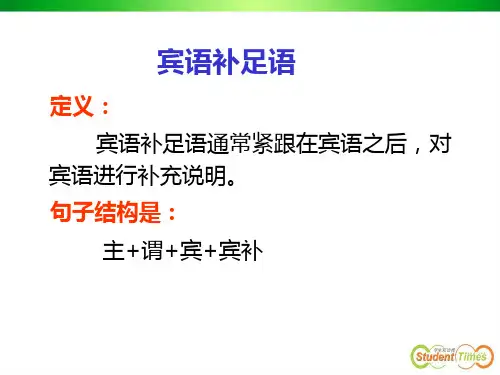
宾语补足语总汇六、具体说明:〔一〕副词作宾语补足语I found him in yesterday.〔二〕常接形容词作宾语补足语的动词有:keep, make, find等。
如:We must keep our classroom clean.〔三〕常接名词作宾语补足语的动词有:call, name, make, think等。
如:We call them mooncakes.〔四〕常接动词-ing形式作宾语补足语的动词有:see, watch, hear, find, keep等。
如:In the country, we can hear birds singing.〔五〕常接介词短语作宾语补足语的动词有:keep, find, leave等。
如:I left my pen on my desk at home.〔六〕不定式作宾语补足语1. 常接带to的动词不定式作宾语补足语的动词有:ask, tell, want, teach, wish等;2. 接不带to的动词不定式作宾语补足语的动词有:see, watch, hear, make, let advise, allow, ask, beg, command, tell, invite, force, oblige, get, help, encourage, persuade, permit, remind, request, order, warn, cause等。
如:I often see him play football.She often asks me to help her.We don't allow such things to happen again.Most of the parents agree to forbid their children to smoke.She asked me to answer the phone in her absence.Please remind me to leave her this note.She requested him to go with her.3. 用不定式作宾语补足语的几种说明:①help后面作宾语补足语的动词不定式能够带to也能够不带to。
分词、不定式作宾补用法要点一、分词、不定式作宾语补足语的区别1.感官动词see, watch, observe, look at, hear, listen to, notice 等和使役动词have 后面的宾补有三种形式,即原形动词(不带to 的不定式)、现在分词和过去分词。
现在分词表主动或正在进行,过去分词表被动或完成,动词原形表主动和完成。
如:I heard her sing an English song just now.刚才我听见她唱了一首英文歌。
I heard her singing an English song when I passed by her room yesterday.昨天经过她房间时,我听见她在唱英文歌。
I heard the English song sung many times.我多次听到有人唱这首英文歌。
注意:不及物动词的过去分词作宾补表完成和状态。
如:I looked down at my neck and found my necklace gone. (状态)I was surprised to find my hometown changed so much. (完成)2.leave 后接三种形式作宾补时,其中的leave 保留了原来之义“留下”,但表达的确切之义应是“使……处于某种状态)。
leave sb. doing sth. 让某人一直做某事(宾语和宾补之间是主谓关系,表示动作正在进行。
)leave sth. undone 留下某事未做(宾语和宾补之间是动宾关系,表示被动和完成,一般以undone, unfinished, unsettled, untouched 为多)leave sb. to do sth. 留下某人做某事leave sth. to be done 留下某事要做(不定式表示将来的动作。
)如:It’s wrong of you to leave the machine running.你让机器一直开着是不对的。
宾语补足语总汇之袁州冬雪创作六、详细说明:(一)副词作宾语补足语I found him in yesterday.(二)常接形容词作宾语补足语的动词有:keep, make, find等.如:We must keep our classroom clean.(三)常接名词作宾语补足语的动词有:call, name, make, think等.如:We call them mooncakes.(四)常接动词-ing形式作宾语补足语的动词有:see, watch, hear, find, keep等.如:In the country, we can hear birds singing.(五)常接介词短语作宾语补足语的动词有:keep, find, leave等.如:I left my pen on my desk at home.(六)不定式作宾语补足语1. 常接带to的动词不定式作宾语补足语的动词有:ask, tell, want, teach, wish等;2. 接不带to的动词不定式作宾语补足语的动词有:see, watch, hear, make, let advise, allow, ask, beg, command, tell, invite, force, oblige, get, help,encourage, persuade, permit, remind, request, order, warn, cause等.如:I often see him play football.She often asks me to help her.We don't allow such things to happen again.Most of the parents agree to forbid their childrento smoke.She asked me to answer the phone in her absence. Please remind me to leave her this note.She requested him to go with her.3. 用不定式作宾语补足语的几种说明:①help后面作宾语补足语的动词不定式可以带to也可以不带to.如:I often help my mother(to) do some housework.②在使役动词后作宾语补足语,不定式不带to.有些动词跟不定式作宾语补足语时省去了to,这些动词有:一感二听三让四观看.一感:feel二听:hear, listen to三让:let, have, make四观看:observe, see, watch, look at这类动词有:make, let, have等.转为主动语态时,其后通常都用带to的不定式 (have没有主动语态). What would you have me do?你要我做什么?She made him give up smoking.她让他戒了烟. Let him do whatever he wishes to do.他想干什么就让他干吧.Though he had often made his little sister cry, today he was made to cry by his littlesister. 虽然常常是他弄哭小mm,但今天他却被小mm弄哭了3. 掌握“使役动词 have + 宾语+过去分词”的几种含义在“ have +宾语+过去分词”布局中,过去分词作宾语补足语, have 也可用 get .这一布局具有以下几种含义:①意为“主语请他人做某事”.例如:He wants to have his eyes examined tomorrow.他今天想去检查眼睛.(“检查”的动作由医生来停止)②意为“主语遭遇、遭受某一不愉快、意外的事情”.例如:Be careful, or you'll have your hands hurt.当心,否则会弄伤手的.③意为“使完成某事”,事情既可以是他人做完,也可以由主语参与完成.例如:He had the walls painted this morning.他今早把墙漆了. (主语自己能够参与)④动词不定式也可作一些短语动词的宾语补足语.I'm waiting for James to arrive. 我正等着詹姆斯的到来.He's arranged for a car to pick them up at the station.他已安插了一辆汽车去车站接他们.The UN has called on both sides to observe the cease fire.结合国号召交战双方遵守停火协定.(七)分词作宾语补足语用现在分词作宾补,说明宾语是动作的发出者,形成逻辑上的主谓关系;用过去分词作宾补,暗示宾语是动作的承受者,构成逻辑上的动宾关系.1. 跟分词作宾补的动词有:catch, have get, keep, hear, find, feel, leave, make, want, start, notice, observe, watch, set等.例如:There was so much noise t hat the speaker couldn’t make himself heard.由于十分吵闹,讲话人没法让人听到他的声音.When he awoke, he found himself being looked after by an old woman.他醒来的时候发现一位老迈娘正在照顾他.2. 几种用过去分词作宾语补足语的情况说明:①暗示“意欲;饬令”的动词,如 like, want, wish, order 等,可用过去分词作宾语补足语.例如:The father wants his daughter taught the piano.这位父亲想让女儿学钢琴.②感官动词 see, hear, notice, observe, watch, feel, find 等后,可用过去分词作宾语补足语.例如:I saw an old man knocked down by a car just now.刚才我看到一位白叟被车撞倒了.③使役动词 have, get, make, leave, keep等后可用过去分词作宾语补足语.例如:Have you got your films developed? 你拿菲林去冲洗了没有?④“ with +宾语+过去分词”布局中,过去分词用作介词 with 的宾语补足语.这一布局通常在句中作时间、方式、条件、原因等状语.例如:The murderer was brought in, with his hands tied behind his back.凶手被带出去了,他的双手被绑在眼前.(表方式)With water heated, we can see the steam.水一被加热,我们就会看到水蒸气.(表条件)With the matter settled, we all went home.事情得到处理,我们都回家了.(表原因)V.+宾语+宾补高考全解析“动词+宾语+宾补”的试题是高测验题中常考的知识点,这里呢,我就高考常考的能跟接“宾语+宾补”复合布局的动词停止着重讲解,以帮忙大家掌握这一知识点:一、“make+宾语+宾补”的用法“make+宾语+宾补”这一布局中,宾语补足语可以由名词、形容词、过去分词、不定式等来充当,例如:(1)A good friend is someone who makes you happy.(形容词作宾补)(2)They made me repeat the story.(省to的动词不定式)(3)He raised his voice to make himself heard.(过去分词作宾补) 注:“make+宾语+宾补”布局中不必现在分词充当宾补.(4)We made him monitor of our class.(名词作宾补)注:职务名词充当宾补时其前面不要加冠词. 【高测验题链接】1. He is very popular among his students as healways tries to make them _____ in his lectures.(07江苏卷)A.interested B.interesting C.interest D.to interest2. My parents have always made me _____ aboutmyself, even when I was twelve. A.feeling well B.feeling good C.feel well D.feel good答案:1.A 2.D二、“with+宾语+宾补”的用法“with+宾语+宾补”是高测验题中考察十分频繁的布局,“with+宾语+宾补”布局中的宾补主要有形容词、现在分词、过去分词、动词不定式等,在考题中常要求选择宾补的形式,在选择时宾补空间该使用什么形式,主要限决于宾语与宾补的关系,主动关系用现在分词,主动关系则用过去分词,此外,不定式作宾补要暗示含义为将来的意味,例如:(1)With so many people communicating in Englishevery day, it will become more and more importantto have a good knowledge of English.(宾语so many people与communicate是主动关系,因此用现在分词作宾补)(2)With everything he needed to buy, he went intothe store.(不定式作宾补暗示将来的含义)(3)With everything he needed bought, he left the store.(过去分词作宾补表主动表完成)(4)With my key lost, I couldn’t enter my room.(过去分词作宾补)(5)With nothing to do, I went out for a walk.(不定式作宾补)(6)I went out with the window open.(形容词作宾补) 别的,“with+宾语+宾补”布局中还可由介词短语、副词短语来充当宾补,如:(1) She said good-bye with tears in her eyes.(2) He left the room with the light still on.【高测验题链接】1.—Come on, please give me some ideas about the project. —Sorry. With so much work ______ my mind, I almost break down.A.filled B.filling C.tofill D.being filled2. John received an invitation to dinner, and withhis work ______ he gladly accepted it.A.finished B.finishing C.havingfinished D.was finished3. I couldn’t do my homework with all thenoise______.(05北京)A.going on B.goes on C.went on D.to go on 答案:1. B 2. A 3. A三、“have+宾语+宾补”的用法在“have+宾语+宾补”这一布局用法中,充当宾补的常常使用的有do,doing,done和adj,例如:(1) I’ll have my hair cut this afternoon.我今天下午要剃头.(2) I won’t have you saying to your mother that way.(3) He realized that she did not wish to haveher go with him.(4) I expect Amy will have the tea readydirectly. 注意:have sth done的含义为“请他人来做某事或遭遇到某到情况”,例如: (1)I had the door painted last week.(2)He had his pocket picked.(3)She had her watch stolen. 【高测验题链接】1. Jenny hopes that Mr. Smith will suggest a goodway to have her written English _____ in a shortperiod.A.improved B.improving C.to improve D.improve2.—Did Peter fix the computer himself? —He_____, because he doesn’t know much aboutcomputers.(07安徽卷)A.has it fixed B.had fixed it C.had itfixed D.fixed it 3.You should understandthe traffic rule by now. You’ve had it _____ often enough.(05天津) A.explaining B.to explain C.explain D.explained答案:1. A 2. C 3. D四、“find+宾语+宾补”的用法“find+宾语+宾补”这一布局中的宾语补足语可以由现在分词、过去分词、名词、形容词、副词、介词短语以及不定式to be等来充当.分别举例如下:(1)You will find it a very difficult book.(2)The youth found it a hard problem to thinkabout.(3)When he came to himself, he found himself surrounded by a group of boys. (4)I hope to find you in better spirits when we meet again.(5)I find the Chinese people to be happy and cheerful.注意:find+宾语+宾补这一布局中通常不使用动词原形来充当宾语补足语,即没有“find+宾语+动词原形”这样的布局. 【高测验题链接】A cook will be immediately fired if he is found____ in the kitchen.(03全国卷) A.smoke B.smoking C.to smoke D.smoked 答案:B. 五、“leave+宾语+宾补”的用法Leave+宾语+宾语补足语,其中宾语补足这一成分可以由过去分词、现在分词、形容词、介词的复合布局等来充当,分述如下:1.由过去分词来充当宾语补足语:leave sth/sb done,常常使用来暗示宾语所处的状态或暗示动作已经完成.(1)Please excuse me if I have left any of your questions unanswered.(2)He got up slowly leaving the lunch unfinished.(3)Did you leave the doors and windows firmly fastened? △可用于主动语态: Hi!My patient can’t be left unattached.2.由现在分词来充当宾语补足语:leave sb/sth doing,常常使用来暗示使或人或某物一直做某事: (1)Don’t leave her waiting outside in the rain.(2)They went off together and left me sitting there. (3)We left him painting the gate. △可用于主动语态: Now the temple has only its walls left standing. The papers were left lying around.3.由形容词来充当宾语补足语: (1)You’d better leave the drawing-room door open. (2)His illness has left him weak. △可用于主动语态: The window was left open.4.由介词的复合布局充当宾语补足语: (1)Leave him in peace! (2)His illness left him with a weak heart.(3)You’ve left her name off the list. △可用于主动语态: I was left without a ray of hope. 【高测验题链接】A good story does not necessarily have to have a happy ending, but the reader must not beleft______.(06天津卷) A.unsatisfied B.unsatisfying C.to be unsatisfying D.being unsatisfied 答案:A六、“hear+宾语+宾补”的用法“hear+宾语+宾补”这一布局中的宾补常可以由现在分词、不带to的不定式、过去分词等来充当,如:Through the wall he could hear Harris cleaning histeeth. She could hear the rain pattering againstthe windows. Have you ever heard a pop song sungin Japanese? I won’t hear anything said againsthim behind his back. 【高测验题链接】 After aknock at the door, the child heard his mother’svoice _____ him.(07上海卷) A.callingB.called C.being called D.to call答案:A.。
动词加后不定式或动名词作宾语或宾补动词后加原形:1. Will / Would you please + ( not ) + V(原)…..?2.Why not +V(原)…..? = Why don’t you + V(原)3. had better ( not ) +V(原) (即加动词不定式省to)使役动词或感官动词后加动词不定式省to:1. let / make / have sb. do….让/使某人做…2. watch /see / hear / notice / feel sb. do….注意:在主动语态中省to的不定式在被动语态中要加to对比:1. hear / see sb. do…. 听见 / 看见…做了…hear / see sb. doing…. 听见 / 看见…正做…2. used to do…. 过去常常做… ,be / get/ become used to doing….习惯于做…be used for doing….被用于做…be used to do….被用于做…动词后面加不定式:1. tell sb.(not ) to do..告诉某人(不)做… ask sb.( not ) to do..叫某人(不)做…2. want to do ..= would like to do.. 想做….3. want sb. to do.. = would like sb to do.. 想要某人做…4. plan to do..计划做…5. begin to do../ start to do.. 开始做…6. try to do.. 努力/尽力做…7. love to do..喜欢做…8. call to do ..打电话做…9. hope to do.., hope( that)+句子.. 希望做…10. be sorry to do..很抱歉做…11. encourage sb. to do .. 鼓励某人做…12. help (sb) (to) do.. 帮助某人做…13. get sb. to do.. 使某人做某事…14. learn to do..学做…15. teach sb. to do..教某人做…16. decide to do ..决定做…17. wish sb. to do ..希望/愿某人做某事18. allow sb. to do..允许某人做…19. warn sb. not to do..警告某人不要做…20. deserve to do.. 注定做…21. (can’t) afford to do.. (不能)负担得起做…22. can’t wait to do..迫不及待做…23. seem to do ..似乎要做…24. be to do ..将要做…25. refuse to do.. 拒绝做…26. agree to do.. 同意做…27. expect to do.. 期望做…28. expect sb. to do ..期望某人做…29. set one’s mind to do.. 一心想做某事30. make up one’s mind to do..下定决心做某事31. prefer to do.. rather than do..宁愿做…而不做…32. It takes sb. some time to do sth. 花某人多长时间做某事33. It’s + adj. + (for sb. ) to do..(对于某人来说)做某事是…样的34. sb. finds it. to do.. 某人发现做某事…35. It’s better / best ( for sb.) to do.. 较好/最好做…动词后面加动名词:1. enjoy doing…2. finish doing…3. hate doing…讨厌做…4. be good at sth. = do well in sth.be good at doing …= do well in doing…5. what / how about doing…?6. thank sb. for doing…感谢某人做…7. have fun doing…做…有乐趣8. have problems / difficult doing…做…有困难/问题9. give up doing..放弃做…10. take part in doing…(积极)参加做…11. make a contribution to doing…做出贡献12. practise doing…13. be worth doing…值得做…14. feel like doing…想要做…15. be interested in doing…对做…感兴趣16. by doing…通过,以…方式17. the way of doing…做…的方法18. keep doing…一直做…19. keep sb. doing…让某人一直做…keep on doing …反复做…20. succeed in doing…成功做某事21. be busy doing…忙于做…22. spend…(in) doing…花时间/钱做…23. can’t help doing …禁不住 / 情不自禁做24. instead of doing…代替做某事25. prefer doing… to doing…宁愿做…而不是做,较喜欢做…而不是做….26. keep / stop / prevent sb. from doing…阻止某人做某事27. mind (sb. / one’s)doing…介意(某人)做…既可加不定式,又可加动名词, 但有区别:1. like doing..表示一般情况like to do.. 表示具体某一次情况2. remember to do..记得要做…(未做)remember doing..记得做过…(已做)3. forget to do.. 忘记要做…(未做)forget doing.. 忘记做过…(已做)4. stop to do..停下来做…(另一件事) stop doing..停止做…(正在做的事)5. go on to do..继续做另一件事go on doing..继续做同一件事6. be afraid to do..不敢做…,害怕做…be afraid of sth. 害怕某物be afraid of doing..害怕做…7. need to do..需要做…need doing .. (某物) 需要被…。